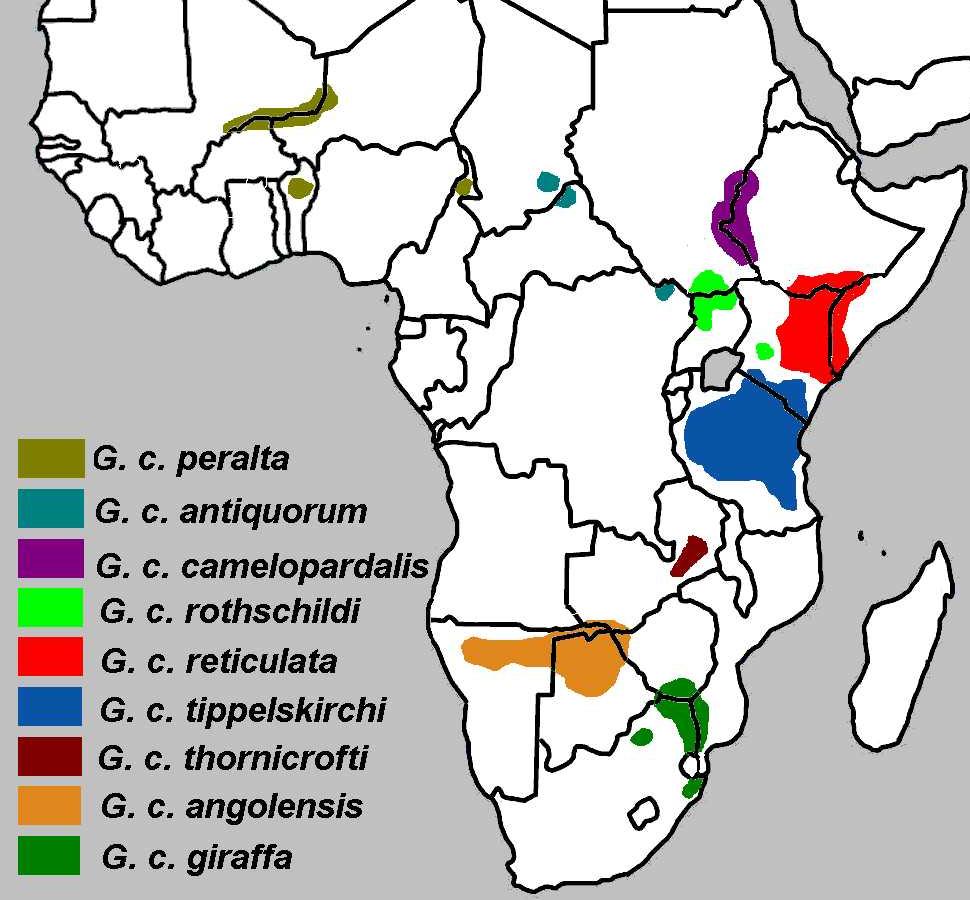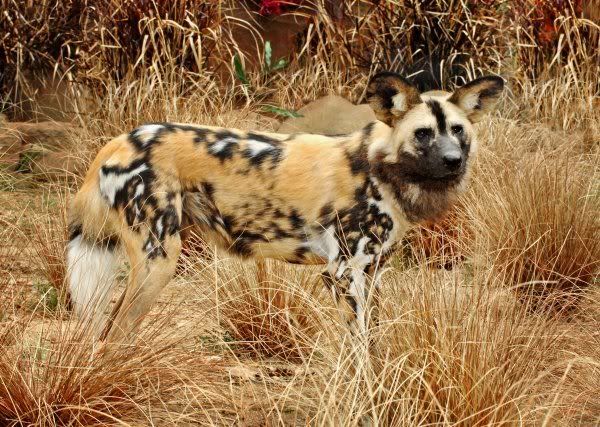Reticulated Giraffes!
- Common Name: Reticulated Giraffe
- Scientific Class: Mammalia
- Scientific Genus/species:Giraffa camelopardis
 Plugin error: That plugin is not available.
Plugin error: That plugin is not available.
And where is this fine animal found, you ask?
Reticulated giraffes are found on the grassy plains of africa. Some adaptions they have made to the grassy plains are that they can go weeks without water, they have long necks to reach to the high tree tops for food, and they have good eyesight so that they can see predators from a distance. These plains are one of many savanna biomes.
- found in Kenya, Sudan, and Eritrea

(Reticulated giraffe in red)
Desciption
The reticulated giraffe has skin and short fur covered in brown polygon shaped spots on them spaced out by creamy-colored lines. They has horns on the top of their head inbetween their ears. Reticulated giraffes have four to toed hooves and a long tail. They also have brown hairs all down the back of their necks. Reticulated giraffes have very long necks, the giraffe is the tallest mammal on the earth.
- length: 12-15 feet
- height:14-19 feet
- weight:1,700-4,200 pounds

Ectothermic or Endothermic?
Ectothermic means warm blooded which means that the reticulated giraffe is warm blooded. All mammals are warm blooded. Reptiles are ectothermic, which means that they are cold blooded. As ectothermic animals they try to keep their body temperature about the same temperature as the outside.
- Bony fish= ectothermic, ex. perch, blue gill, musky
- Amphibians= ectothermic, ex. newt, frog, toad, salamander
- Reptiles= ectothermic, ex. turtle, crocodile, gecko, snake, skink
- Birds= endothermic, ex. penguin, swan, finch, blue jay, chickadee
- Mammals= endothermic, ex. cat, dog, cattle, goat, hog, anteater, ape, people, giraffe, whale
Young/Social Groups
- live in social groups called herds or towers
- Name of young: calves
- 2 related species include caribou and okapi
Caribou:

Okapi:

Okapi are the closest related species to reticulated giraffes.
Giraffe subspecies include:
- Reticulated
- Smoky
- Kordofan
- Masai
- Nubian
- Rothschild
- South African
- Nigerian
- Rhodesian
Diet?
You may think that reticulated giraffes are herbivores, you are correct! Reticulated giraffes are typically herbivores, they may eat the young of a bird known as the weaver bird or chew on bones. Giraffes use their tongue for eating.
eats:
- leaves
- shoots
- flowers
- vines
- herbs
- weaver bird nests thet may have young in them
Giraffes are not carnivores there for there are other animals that eat them(even though some carnivores are eaten by other carnivores). Reticulated giraffes have a numerous amount of predators.
predators:
- lions

- Hyenas

- Wild dogs

- Leopards

They can kick an enemy with their back legs and when they kick it is hard. Giraffes will usually run away from a predator.

Symbiotic Relationships
One symbiotic relationship between the reticulated giraffe and another living organism is a tickbird and a reticulated giraffe. The tickbirdeats insects off the giraffe's skin and they give a warning chirp to tell when a predator is coming. This is a mutual relationship.

Forms of Communication
Most think that reticulated giraffes make no sound, but those of you who say that are wrong. Giraffes make many noises. They may look graceful and soundless, but they really make many sounds when you are not looking.
communication:
- loud coughing noises
- whistles
- bellows
- bleats
- mooing
- mewing by calves
Endangered?
Nope! The reticulated giraffe is close to it though, but there are many animal preserves in Africa. Poachers had been hunting reticulated giraffes. Poaching is hunting an animal illegally.
trouble causers:
- poachers
- lions
- hyenas
- leopards
- wild dogs
Interesting or unusual facts!
Reticulated giraffes are very interesting and unusual creatures. They are very glaceful mammals. Giraffes are on the endangered animals list because of poachers. There are many animal reserves in africa, and many zoos have captive giraffes. Though fun to watch when they are in captivity you must think about how they feel, like all animals in captivity.Giraffes are fun to learn about and fun to watch. Here are some fun tid bits of information.
- spend half their time eating
- can go a few days without drinking
- walks with left front leg and left back leg then the right ones, etc.
Sources!
http://en.wikipedia.org/wiki/Reticulated_Giraffe
http://www.stlzoo.org/animals/abouttheanimals/mammals/hoofedmammals/reticulatedgiraffe.htm
http://www.oaklandzoo.org/animals/mammals/giraffe-reticulated/
http://en.wikipedia.org/wiki/Giraffe_camelopardis
http://www.cbc.ca/technology/story/2007/12/24/science-giraffe.htnl?ref=rss
http://encarta.msn.com/encyclopedia_761561060/giraffe.html
http://www.buzzle.com/articles/giraffe-facts.html
http://www.pbs.org/wnet/nature/giraffe.html
http://en.wikipedia.org/wiki/Giraffe
Giraffes and Other Hoofed Mammals
pg. 22, 26, 34, 40 c2001
author: Meish Goldish